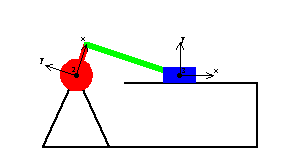10.2.1 Example MechanismThis simple planar slider-crank model is presented with little explanation because all of the techniques used in the model have been explored in previous chapters.
The one feature of interest in this model is the velocity-dependent applied loading. Two loads are applied, a driving moment on the crank and a viscous friction on the slider. Note that the driving moment applied to the crank is a function of velocity such that the moment drops to zero as velocity increases. This is done so that the velocity will not approach infinity when the piston is not moving at top-dead-center and bottom-dead-center. This loads the Modeler2D package and defines names for each of the body numbers. Here are the constraints for the slider-crank model. Here are the velocity-dependent applied loads. Note that the force on the slider always opposes its direction of motion. Here is the moment that is applied to the crank by the rotational constraint at T = 0.2.
Out[8]= |  |
Here is the slider-crank model at T = 0.2.

|